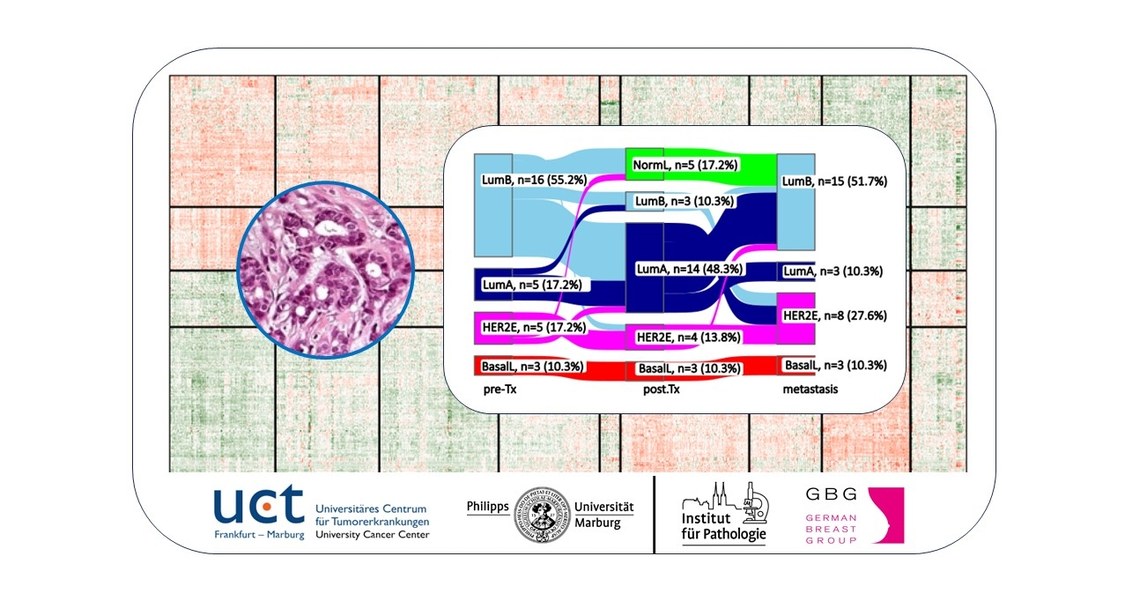12.02.2025 New perspectives for breast cancer therapy: Adaptive tumor changes as the key to a better prognosis
Study: Tumors change under chemotherapy - new subtypes could improve treatment success

A Hessian research team from the University Cancer Center (UCT) Frankfurt-Marburg and the GBG, led by Prof. Dr. Carsten Denkert (Marburg) and Prof. Sibylle Loibl (Frankfurt), has gained groundbreaking insights into molecular heterogeneity in so-called luminal (HR+/HER2-negative) breast cancer in a recent study. The study, which was published in the renowned journal Cancer Cell, shows that tumors change dynamically under neoadjuvant chemotherapy. Existing classification systems could therefore be expanded in order to tailor treatment more specifically to patients.
Changes in tumor tissue influence the prognosis
The researchers analyzed 1454 tissue samples from more than 500 patients from the international phase 3 clinical trial Penelope-B. They specifically compared samples taken before the start of chemotherapy with samples taken after therapy. They found that aggressive tumors of the luminal B type often change into a less aggressive luminal A form during therapy. In later metastatic stages, however, some of the tumors can revert back to the more aggressive Luminal B phenotype.
"The classification into luminal A and luminal B is useful for an initial characterization, but not sufficient," explains Prof. Denkert. "Our research shows that the tumor adapts to the therapy and changes its behavior as a result. To make treatment more effective, we need to look not only at a snapshot of the tumor, but also analyze its development over time."
Adaptive subtypes as a new classification approach
Based on their findings, the scientists developed a new classification, the so-called adaptive clusters (AC subtypes). This is based on the individualized comparison of tumor samples before and after chemotherapy. The subtypes provide information on whether a patient has a high or low risk of tumor recurrence.
"With the AC subtypes, we can better predict which patients will benefit from more intensive follow-up treatment and which could receive less aggressive therapy," says Prof. Loibl.
New perspectives for personalized cancer therapy
The study provides the basis for the further development of personalized therapy concepts in oncology. It shows that it is not enough to classify breast cancer solely according to conventional subtypes. Rather, the response to therapy should be taken into account in order to select the best individual treatment strategy.
"Our research findings lay the foundation for a more precise classification of breast cancer and could help to adapt treatment more specifically to the course of the disease in future," summarizes Denkert.
The results must now be validated in further studies before they can be adopted in clinical practice. In the long term they could help to increase the effectiveness of therapy and avoid unnecessary side effects for patients.
The investigations were funded by German Cancer Aid in the Translational Oncology Program (Integrate-TN, #70113450) and by the German Federal Ministry of Education and Research (BMBF) in the joint research project SATURN3 (#01KD2206M).
Breast cancer background: Luminal breast cancer is a subgroup of breast cancer based on molecular characteristics. It is the most common subtype of breast cancer (70% of all cases). Luminal tumors are positive for hormone receptors. This classification is typically determined by examination of tissue samples or gene expression testing. Luminal breast cancer is further divided into two main categories: Luminal A and Luminal B. However, as the current Marburg study shows, an extended, refined classification could be decisive for successful treatment.
Background UCT-FM: The UCT Frankfurt-Marburg is a Comprehensive Cancer Center consortium of the University Medical Center Frankfurt, the Northwest Hospital and the University Hospital Marburg. It networks interdisciplinary patient and promotes joint translational and clinical cancer research as well as the training of medical specialists and scientists in oncology. German Cancer Aid has recognized the UCT Frankfurt-Marburg as one of 14 German Oncology Centers of Excellence. Further information can be found on the UCT-Frankfurt Marburg website: https://www.uct-frankfurt-marburg.de
Background GBG: GBG Forschungs GmbH is an academic research institute in the south of Frankfurt with a focus on breast cancer therapy. GBG conducts phase II-III clinical trials on its own responsibility or as a service provider. GBG is strongly committed to patient-oriented translational research. Further information https://www.gbg.de or linkedin
Original publication: Carsten Denkert, Sibylle Loibl et al, (2025) Cancer Cell 43, 232-247, DOI: https://doi.org/10.1016/j.ccell.2025.01.002
Contact
Prof. Dr. Carsten Denkert
Tel.: 06421 58 62271
Mail: carsten.denkert@uni-marburg.de
Institute of Pathology
Philipps University Marburg